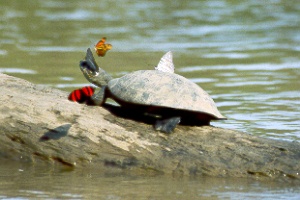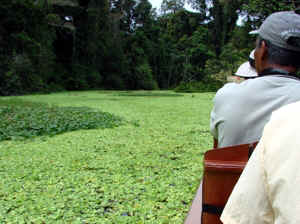

Destinations
Experiences
 |
L A
D A T C O T O U R
S |
 |
||||||||
| HOME | South America | Falkland Islands | Antarctica | Unique Destinations |
Unique Experiences |
Newsstand | ||||
 |
RAINFORESTS: Fascinating Facts
|
 |
The following are excerpts from an article
"25 Fascinating Facts about the Amazon Every Visitor Should Know" written by Daniela Hart
that appeared in the October 1998 issue of HEMISPHERES, the United Airlines In-flight magazine:1) The Amazon region is the world's largest continuous tropical rain forest, situated in the giant basin of the world's largest river, the mighty Amazon. The region covers an area of 5.1 million square kilometers, about half the size of Europe. The Amazon River, with 1,100 tributaries, contains one-fifth of all the planet's fresh water.
2) The Amazon spans nine South American countries: Brasil, Bolivia, Peru, Ecuador, Colombia, Venezuela, Guyana, French Guiana and Suriname. Sixty percent of the total lies in Brasil.
3) The name Amazon comes from the greek myth of the Amazonas, powerful women warriors whose valor and war cry had a "fearful effect" on their adversaries, according to Bulfinch's Myths of Greece and Rome. In the 16th century, the Spanish explorer Francisco de Orellana reported encounters with wild women warriors on the banks of the river, which was named Amazon in their honor. Nobody has seen them since.
4) Manaus, capital of the Brazilian state of Amazonas, is the place from which to start exploring the region. The best hotel is the five-star Tropical Manaus set among luscious tropical gardens on the banks of the Negro River.
5) A can't-miss trip from Manaus is the "meeting of the waters" where the light brown waters of the Solimoes meet the dark waters of the Negro to form the mighty Amazon. The different-colored waters sun alongside one another for miles without mixing.
6) The Amazon Theater in Manaus was built in 1896, at the height of the rubber boom, when the local elite gloried in fancy evenings with the best in world opera and music. Built in Europe with Italian marble, Murano crystal chandeliers and English iron stairways, it was brought over by boat to be assembled in Brasil. Today it is the home of the Amazonian Philharmonic Orchestra.
7) Fortunes were made in the Amazon during the rubber boom (roughly 1870-1910). But in the late 1800's, an Englishman smuggled some Hevea rubber-tree seeds to Kew Gardens in London (legend has it they were hidden inside his walking stick). Later transplanted to plantations in Southeast Asia, these seeds were to spell the end of the Amazon's monopoly on rubber and its phase of riches and glory.
8) Stay for a few nights in a jungle lodge to observe wildlife at close quarters.
NOTE from LADATCO: Specific recommendations as to lodges are omitted on purpose as there are today
many more options than the two included in the article.9) The symbol of the Amazon is the giant, floating vitoria-regia (royal water lily), up to two meters in diameter. A local myth tells of a young girl who fell in love with the moon. She saw its reflection in the water one night, dived in to be with her beloved, and drowned. In sorrow, the moon transformed her into the star of the waters, the lovely vitoria-regia.
10) The Amazon is an angler's paradise. Between August and October, and again between January and April, you can catch prizewinning peacock bass while cruising the river in a comfortable air-conditioned boat.
11) The largest mammal in the region is the manatee, which looks a bit like a floating hippopotamus, weighing up to 500 kilograms. Its tasty meat has long made it a favorite prey for hunters; it is now in danger of extinction.
12) Until the 1960's, the Amazon forest was virtually untouched. But over the last 30 years, in Brazil alone an area of forest larger than France has been destroyed by logging, burning and mining. The rate of destruction slowed significantly in the 90's but lately has been picking up again.
13) The Amazon forest is full of world records. It has the largest beetle, the Titanus gigantus, 20 centimeters long; the largest eagle, the Harpia amazonica, 97 centimeters high; the largest moth, the emperor moth, 30 centimeters wide; the largest freshwater fish, the pirarucu, up to 3 meters long; and the smallest monkey, the sagui, or pygmy marmoset, which reaches a length of only 15 centimeters and weighs only about 100 grams.
14) The Brazilian Amazon is home to 170,000 Indians belonging to 210 different tribes, many still living as hunter-gatherers in the ways of their ancestors. Encroaching civilization, however, has brought many new diseases and the devastation of their hunting and fishing grounds.
15) The Amazon boasts the world's largest variety of species of primates, birds, alligators, frogs, insects, rodents and lizards. There are an estimated 10 million to 15 million species of insects and 300 species of reptiles. But don't worry: You won't meet most of them.
16) In the Amazon region live the largest number of species of freshwater fish in the world, between 2,000 and 3,000. The Negro River alone has more species than all the rivers of Europe combined.
17) An exquisite, not-to-be-missed delicacy is fresh Amazon fish roasted on charcoal or cooked in banana leaves or coconut sauce. Favorites are tucunare (peacock bass), tambaqui, and pirarucu. For dessert, try some of the exotic forest fruit, fresh or made into delicious ice creams.
18) New species of plants and animals are continually being found in the Amazon. Just since 1990, seven new species of monkeys were found and 12 species of fish. Of the estimated 5 million to 30 million species of plants in the forest, only 30,000 have been studied and identified.
19) The best time to go is June and July, when full rivers allow access to the more remote parts of the jungle, and mosquitoes are scarce. December to May is the rainy season in most parts of the region. It's hot year-round.
20) One of the most curious plants in the Amazon is the delicate, sweetly scented moon-flower (Strophocactus selenicereus wittii). It opens every few years for one night only.
21) In some rivers of the Amazon region, the difference in water level between the dry and rainy seasons is equivalent to the height of an eight-story building. Many houses, shops, and even vegetable gardens are built on floating logs and tied to the shore.
22) You can buy Amazonian herbs, basketware, and objects made of terra cotta and wood at the Mercado Municipal (central market) in Manaus and Indian crafts at the Indian Museum. Here there are also exhibits of featherwork and Indian articles from many tribes.
23) The Amazon is very sparsely populated, with only 19 million inhabitants in an area the size of the continental United States. You can travel for days without seeing any sign of human habitation, just forest and river and wildlife.
24) The largest recently contacted Indian nation is the Yanomamo, with a population of about 22,000 in Brasil and Venezuela. Contact for them has also meant destruction, as miners invade their lands in search of gold and other precious minerals. It is estimated that there are still about 50 isolated tribes living in the forest with no contact at all with technological society.
25) According to the Indians, a wise person walks the earth like a bird flying across the skies - leaving no marks. This is how they have lived for centuries in the forest without harming it.